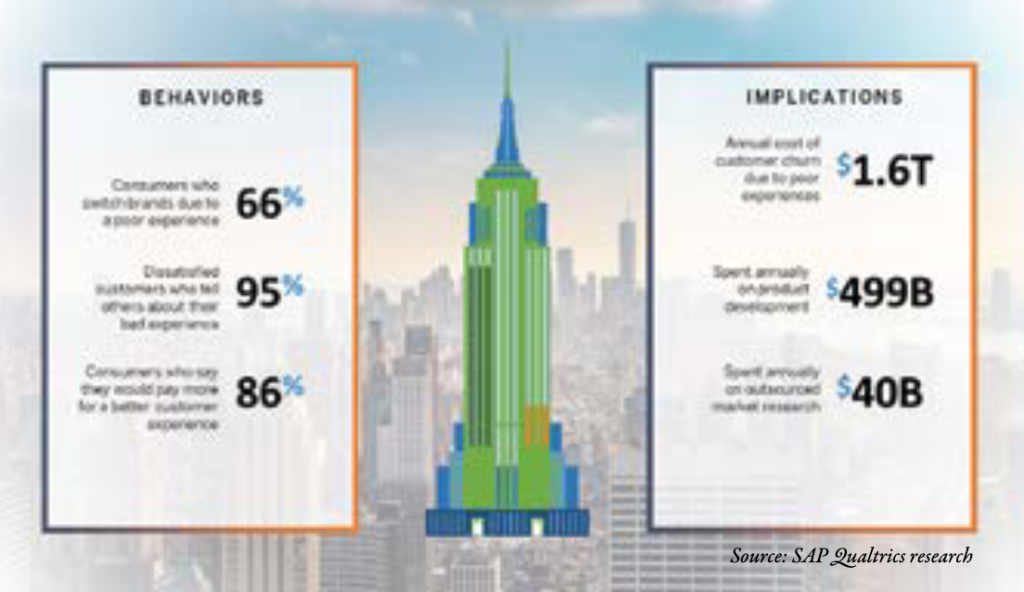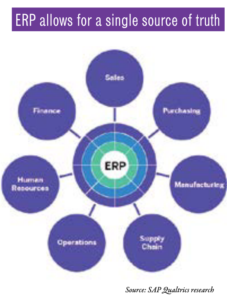Connections

M&E Journal: Content May Be King, But Is Content Enough?
Story Highlights
SAP will host the Sept. 10 webinar “Brace Yourselves for the Next Disruption in the Media Industry”
By Richard Whittington, SVP M&E, SAP –
The maxim that “content is king” has long been an unquestioned principle in the media industry, but perhaps it’s time to reconsider this.Research has shown that improving customer experience yields impressive returns. For example, Apple stores with roving sales assistants, friction-less commerce at checkout and the “genius bar” have transformed how we buy phones, computers and tablets.
This customer/product/brand experience allowed Apple to price its products at a premium and deliver exceptional stock returns. Apple opened its first 25 stores in 2001. A $100 investment in Apple’s stock at the beginning of 2002 would have grown to more than 130 times the original investment by mid-October 2019. A significant part of that growth can be attributed to the customer experience.So, what does this mean for the media industry? Our point of view is that we are at the “minimum viable product stage” — as we say in the technology world — of direct-to-consumer (D2C) in media.
Yes, content is a large part of the initial success and will continue to play a substantial role BUT the ability to match that content to the right consumer at the right moment will become the “Apple Store/Amazon” of media. Amazon and Apple are noteworthy because their ventures into content were part of larger strategies.
 Amazon leverages its content as a way to add value to its Prime subscriptions, while Apple uses con-tent to sell devices, as well as to build an adjacent revenue stream with its subscription services.
Amazon leverages its content as a way to add value to its Prime subscriptions, while Apple uses con-tent to sell devices, as well as to build an adjacent revenue stream with its subscription services.
Of course, incumbent media companies are not standing still. Disney is enjoying early success with the domestic launch of its D2C service, Disney+. Next up are services such as Warner Media’s HBOMax, and NBCU’s Peacock, as well as the yet-to-be-named offering from ViacomCBS.
As the landscape grows more competitive, we are faced with some critical questions:
*What will be the consumer’s threshold in terms of the number of monthly subscriptions?
*Will a couple of popular shows be enough to keep the subscription viable in the consumer’s eyes?
*Will subscribers hop into a service for a particular offering and then hop out once done?
The short answer to all of these questions is that we don’t know. (On the question of how many services consumers will subscribe to, however, estimates vary from one to four — inclusive of music services — per household depending on income level.)
 What we do know is that in industries like retail, the product (in our case the content) is one part, but the customer experience is often more significant.
What we do know is that in industries like retail, the product (in our case the content) is one part, but the customer experience is often more significant.
For example, in media this can range from better seating and in-seat food in the theatrical experience to vir-tual concierge recommendation engines powered by artificial intelligence (AI) or machine learning (ML) in streaming. Many media companies are familiar with the concept of an enterprise system to bring operational data together.
But how many could say the same for bringing customer and customer experience data together in the same way? Early streaming companies like Netflix led the way in consumer data exploration and exploitation but we believe there is so much more potential here in the battle for subscribers and subscriber revenue.
So let’s go on a journey …
It’s been a long work week and Bob has just arrived home. He asks his partner what they should have for dinner, then he places an order via his app. While waiting for dinner to arrive, he turns on his “TV” and asks his voice-controlled assistant to find some-thing to watch that night. In the old world this may have been a simple list of recommendations, but in the customer experience version of media, it might go more like this:
BOB:Find me a movie.
CHATBOT: What kind of week have you had?
BOB: It’s been a tough work week and I would like something relaxing please.
CHATBOT: Are you interested in what your friends have watched in the last month with a “thumbs-up” score of 80% or higher?
BOB: Sure. But no romcoms tonight.
The chatbot looks at Bob’s social graph and finds content that matches Bob’s mood and that his top friends on his social media hangouts are watching and presents Bob with a short list of five titles to watch. Bob and his partner agree on a movie and settle in to enjoy their dinner while watching. However, the first choice isn’t tightly aligned with their mood, so Bob stops it.
CHATBOT: Is there a problem with the content selection?
BOB: No. That is just a bit too slow for me tonight.
CHATBOT: Would you like to watch it at a later date.
Based on the answer, the program adds the movie to the watch list or deletes it. Bob and his partner select the second offering and at the end of the film the chatbot pops up and asks two simple questions:
“Would you recommend it to a friend?” ( the Net Promoter Score) and “Which friends would you like to recommend it to?” Bob’s responses are then stored by the ML part of the platform to help improve the “hit rate” on recommendations, and to target Bob’s friends to either add it to their watch-list or send them a social media message with an offer of a free trial to watch the con-tent.
The chatbot asks a closing question:
CHATBOT: May I help you with anything else?
BOB: Actually, there was a scene in the film where the lead actor was wearing a cool bomber jacket. Where can I buy one like it?
The AI part of the platform identifies the jacket in question, and either on the main screen or a companion app, offers Bob several options to purchase it at various vendors. The transaction is executed, and the film distributor gets a portion of the proceeds. Call this product placement/integration on steroids.
 Sounds too futuristic?
Sounds too futuristic?
Let’s break it down. First, we must know Bob and have Bob opt in, which more than 150 of SAP’s media customers do today thanks to SAP Enterprise Consent and Preference Management.
We also need a strong recommendation engine, which Netflix and many of SAP’s customers employ. Customer experience is driven by companies like Qualtrics, feeding X (experience) data into O (operational) data to marry insight into action.Next, SAP C/4HANA is powering the next generation of music artist-driven commerce to sell to the consumer and settle with revenue share partners. All of this customer experience is orchestrated with conversational AI.
Last, underpinning the end-to-end experience requires a financial platform smart enough to manage the revenue, rights and royalties, and operational analysis to power that customer experience.Let’s look at a D2C brand in retail that has embraced this notion of customer experience, driven by an exceptional product experience built with innovative feedback from its users. Under Armour is a house-hold name. Its customer experience is tightly connected to its product.
Product testing therefore is a significant area of focus, much like audience screening and feedback in media. The outcomes that Under Armour has been able to achieve based on an integrated view of the experience are impressive. In the media industry, these early stages of becoming a D2C business are about balancing consumer experience with great content (product) experience, to delight audiences. For those early adopters it brings in big returns in revenue, profit and share-holder growth.
Just imagine what an incredible opportunity exists for the winner in customer experience AND content.
The king is dead, long live the king!
———————-
Click here to translate this article
Click here to download the complete .PDF version of this article
Click here to download the entire Spring/Summer 2020 M&E Journal









